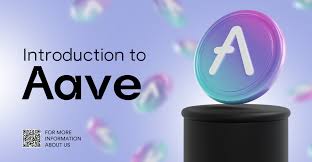In the rapidly expanding world of decentralized finance (DeFi), aave has emerged as a prominent and innovative platform that enables users to lend, borrow, and earn interest on their cryptocurrency assets without the need for a traditional bank or financial intermediary. Launched in 2017 by Stani Kulechov, Aave has grown significantly to become one of the leading DeFi protocols, driven by a powerful mix of innovative features, robust security, and a unique governance model. This article explores Aave’s unique approach to DeFi, the technology behind it, and its implications for the future of financial services.
Understanding Aave: The Basics
Aave is an open-source, non-custodial liquidity protocol built on the Ethereum blockchain, designed to provide decentralized lending and borrowing services. The name “Aave” originates from the Finnish word for “ghost,” symbolizing the protocol’s emphasis on transparency and anonymity. Users can deposit their cryptocurrency into liquidity pools, allowing others to borrow from these pools, with interest rates determined by supply and demand dynamics.
Aave offers both lenders and borrowers the opportunity to earn or pay interest, but it goes further by introducing features like flash loans, collateral swapping, and its native token, $AAVE. Its seamless user experience, wide variety of supported tokens, and community-driven governance have solidified Aave’s position as a pioneer in the DeFi space.
Key Features of Aave
- Flash Loans
One of Aave’s most groundbreaking features is its flash loans, a concept unique to DeFi. Flash loans allow users to borrow funds without collateral, provided they repay the loan within the same transaction block. This capability opens up opportunities for arbitrage, collateral swapping, and debt refinancing, appealing to experienced DeFi users and developers. Flash loans are particularly popular among traders looking to capitalize on price discrepancies between decentralized exchanges, though they require a high level of technical skill. - Interest Rate Flexibility
Aave offers users the option to switch between stable and variable interest rates. Variable interest rates fluctuate based on market conditions, while stable rates provide predictability, similar to a fixed interest rate in traditional finance. This flexibility enables borrowers to manage their risk and adapt to market trends, a feature that adds significant value for long-term borrowers. - Aave’s Governance and Staking with $AAVE
Aave introduced its native governance token, $AAVE, which plays a central role in the platform’s ecosystem. $AAVE holders have voting power in the Aave Improvement Proposals (AIPs), enabling them to participate in decision-making on protocol upgrades, risk parameters, and other critical changes. Additionally, $AAVE can be staked in the Aave Safety Module, a reserve designed to cover potential shortfalls, allowing stakers to earn rewards while supporting the platform’s long-term security. - Cross-Chain Functionality
While Aave initially launched on Ethereum, it has expanded to support multiple blockchains, including Polygon and Avalanche. This cross-chain functionality has enhanced scalability, reduced transaction fees, and opened Aave’s services to a broader user base. With the integration of layer 2 solutions, Aave continues to advance interoperability in the DeFi space, making it accessible to a larger audience.
Aave’s Technology Stack and Security
Aave’s technology leverages smart contracts to execute transactions autonomously, providing users with a high degree of transparency and trustlessness. These smart contracts are publicly accessible and audited by several third-party firms to ensure security, crucial for a platform handling substantial funds daily. By removing intermediaries, Aave significantly reduces costs and the risk of centralized points of failure.
Additionally, Aave’s open-source code allows developers worldwide to build on its platform, contributing to innovation and security improvements. As with all DeFi projects, however, smart contract risks remain, and Aave has implemented various security protocols, such as its Safety Module, to mitigate these risks.
The Future of Aave and DeFi
Aave is leading the way toward decentralized financial services by bridging the gap between traditional finance and cryptocurrency. As DeFi continues to gain traction, Aave’s innovations could disrupt various financial services, from lending to asset management. The integration of real-world assets, such as tokenized stocks and bonds, is one future avenue that could bring even more liquidity and diversity to Aave’s pools.
Moreover, the recent developments in Aave’s governance structure emphasize its commitment to decentralization. As the community takes on a more significant role in shaping the protocol’s future, Aave may become increasingly adaptable and resilient. This adaptability is essential in a rapidly evolving industry where regulatory scrutiny is likely to increase.
Conclusion
Aave has cemented itself as a key player in DeFi by offering innovative financial services that blend traditional and decentralized principles. With features like flash loans, flexible interest rates, a robust governance model, and multi-chain support, Aave provides a compelling value proposition for both newcomers and seasoned DeFi participants. As it continues to innovate and scale, Aave is poised to remain at the forefront of the DeFi revolution, potentially reshaping the financial landscape in ways that were once unimaginable.


